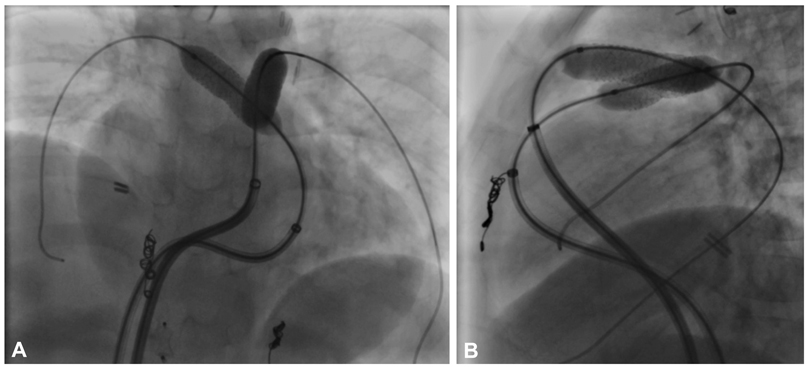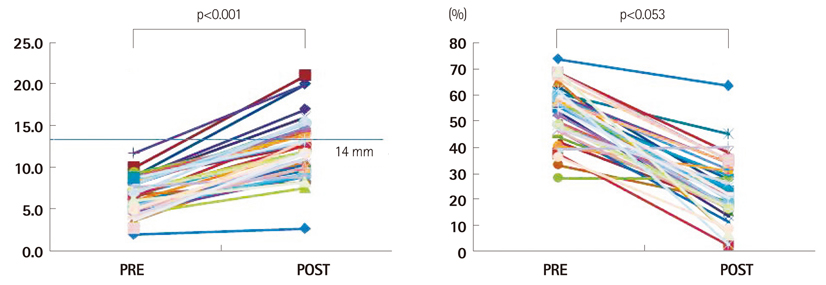Korean Circ J.
2012 Jan;42(1):40-45. 10.4070/kcj.2012.42.1.40.
Effectiveness and Safety of Percutaneous Transcatheter Implantation of Pulmonary Arterial Stent in Congenital Heart Disease
- Affiliations
-
- 1Department of Pediatric Cardiology, Ulsan of Unversity College of Medicine, Asan Medical Center, Seoul, Korea. yhkim@amc.seoul.kr
- 2Department of Pediatric Cardiac Surgery, Ulsan of Unversity College of Medicine, Asan Medical Center, Seoul, Korea.
- KMID: 2297906
- DOI: http://doi.org/10.4070/kcj.2012.42.1.40
Abstract
- BACKGROUND AND OBJECTIVES
Pulmonary arterial stenosis is a relatively common complication after corrective operation of congenital heart disease. Unilateral stenosis of pulmonary arteries could result in decrease perfusion of affected lung, pulmonary regurgitation, or elevation of right ventricular pressure. Eventually there are increasing risks of right ventricular failure, arrhythmia, or sudden death. However we have limited data of pulmonary arterial stent in paediatric population as the treatment of branch pulmonary stenosis. This study aimed at validating the effectiveness and investigating complications of pulmonary arterial stent implantation in a single institution during mid-term follow up period.
SUBJECTS AND METHODS
A total of 42 patients (50 stents) were implanted for treating branch pulmonary arterial stenosis. We used cardiac catheterization for comparing diameter after stent implantation directly and lung perfusion scan indirectly. We also investigated any adverse effect relating the procedure.
RESULTS
Percent stenosis of stenotic lesions were decreased from 54.1+/-10.7% to 22.8+/-12.5% (p<0.001) and degree of decrement in affected lung perfusion was declined from 22.7+/-8.0% to 10.3+/-9.0% (p<0.001) immediately and lasts during mid-term follow up period. Complication rate relating the procedure was 12% (6 out of 12) and there was no mortality case.
CONCLUSION
This series showed immediate and short term effectiveness of pulmonary arterial stent in congenital heart defects. We concluded that percutaneous transcatheter implantation of pulmonary arterial stent was safe and effective during short and mid-term follow up period.
Keyword
MeSH Terms
Figure
Reference
-
1. Mullins CE, O'Laughlin MP, Vick GW 3rd, et al. Implantation of balloon-expandable intravascular grafts by catheterization in pulmonary arteries and systemic veins. Circulation. 1988. 77:188–199.2. Hellenbrand WE. Transcatheter therapy for congenital heart disease. Cardiol Clin. 1988. 6:421–436.3. Rath PC, Sukumar IP. Transcatheter therapy for congenital heart disease. J Assoc Physicians India. 1986. 34:199–201.4. Chaturvedi RR, Kilner PJ, White PA, Bishop A, Szwarc R, Redington AN. Increased airway pressure and simulated branch pulmonary artery stenosis increase pulmonary regurgitation after repair of tetralogy of Fallot. Real-time analysis with a conductance catheter technique. Circulation. 1997. 95:643–649.5. Fogelman R, Nykanen D, Smallhorn JF, McCrindle BW, Freedom RM, Benson LN. Endovascular stents in the pulmonary circulation: clinical impact on management and medium-term follow-up. Circulation. 1995. 92:881–885.6. Oyen WJ, van Oort AM, Tanke RB, van Mill GJ, Aengevaeren WR, Corstens FH. Pulmonary perfusion after endovascular stenting of pulmonary artery stenosis. J Nucl Med. 1995. 36:2006–2008.7. Latson LA. Interventional catheterization for congenital heart disease--limited "surgery" without the chest scar. Clin Pediatr (Phila). 1997. 36:125–127.8. Petit CJ, Gillespie MJ, Harris MA, et al. Relief of branch pulmonary artery stenosis reduces pulmonary valve insufficiency in a swine model. J Thorac Cardiovasc Surg. 2009. 138:382–389.9. Law MA, Shamszad P, Nugent AW, et al. Pulmonary artery stents: long-term follow-up. Catheter Cardiovasc Interv. 2010. 75:757–764.10. Recto MR, Elbl F, Austin E. Use of the new IntraStent for treatment of transverse arch hypoplasia/coarctation of the aorta. Catheter Cardiovasc Interv. 2001. 53:499–503.11. Rutledge JM, Mullins CE, Nihill MR, Grifka RG, Vincent JA. Initial experience with intratherapeutics Intrastent Doublestrut LD stents in patients with congenital heart defects. Catheter Cardiovasc Interv. 2002. 56:541–548.12. Latson LA. Pulmonary artery stents: on target, but still "off label". Catheter Cardiovasc Interv. 2010. 75:765–766.13. Moszura T, Michalak KW, Dryzek P, Moll JA, Moll J, Sysa A. One center experience in pulmonary artery stenting without long vascular sheath. Cardiol J. 2010. 17:149–156.14. Tomita H, Nakanishi T, Hamaoka K, Kobayashi T, Ono Y. Stenting in congenital heart disease: medium- and long-term outcomes from the JPIC stent survey. Circ J. 2010. 74:1676–1683.15. Forbes TJ, Rodriguez-Cruz E, Amin Z, et al. The Genesis stent: a new low-profile stent for use in infants, children, and adults with congenital heart disease. Catheter Cardiovasc Interv. 2003. 59:406–414.16. Breinholt JP, Nugent AW, Law MA, Justino H, Mullins CE, Ing FF. Stent fractures in congenital heart disease. Catheter Cardiovasc Interv. 2008. 72:977–982.17. Ashwath R, Gruenstein D, Siwik E. Percutaneous stent placement in children weighing less than 10 kilograms. Pediatr Cardiol. 2008. 29:562–567.18. Li F, Zhou AQ, Gao W, et al. Therapeutic effect of Cheatham-Platinum stent implantation for vessel stenosis associated with congenital heart disease in children and adolescents. Zhonghua Er Ke Za Zhi. 2009. 47:255–259.19. Maglione J, Bergersen L, Lock JE, McElhinney DB. Ultra-high-pressure balloon angioplasty for treatment of resistant stenoses within or adjacent to previously implanted pulmonary arterial stents. Circ Cardiovasc Interv. 2009. 2:52–58.
- Full Text Links
- Actions
-
Cited
- CITED
-
- Close
- Share
- Similar articles
-
- Recent advances in transcatheter treatment of congenital heart disease
- Percutaneous Pulmonary Valve Implantation
- Pulmonary Arterial Hypertension with Congenital Heart Diseases
- The outcome of percutaneous stent implantation in congenital heart disease: experience of a single institute
- Comparatives Study of Pulmonary Artery and Pulmonary Venous Wedge Pressure in Congenital Heart Disease





